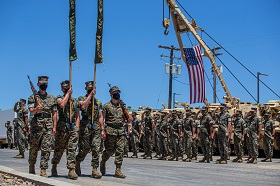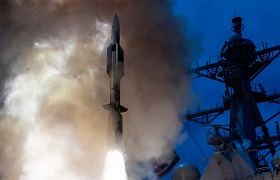Whenever we move into a new year, or a new decade for that matter, predictions for the future abound. While few would dare make any global forecasts after the insanity of 2020, things in many narrower fields continue to move as usual, and the defence industry is just one of them. Fortunately, the active militarization that we have seen in recent years does not look like it is going away any time soon.
Despite numerous advances in technology designed to kill, the soldier in the field remains the backbone of this process. While we have seen some spectacular “aerial wars” in recent decades, they have rarely been conducted without boots on the ground, as the Americans would put it. The increasing value of an individual soldier in developed nations (for obvious economic and demographic reasons) requires that soldier to be more combat efficient. This will remain true for a long time, until the day when we finally see the kind of combat androids that are glorified in sci-fi flicks fighting on the ground, since only something human-like can operate effectively in the anthropogenic urban environment.
Perhaps the most striking challenge for the near future (and if it works, it would be a revolution comparable to the development and use of radio) is to integrate all fighting units on the battlefield into a single network with instant data transfer capability. Modern artillery, rocket and aircraft weapons offer deadly force and precision, which are limited chiefly by the speed and accuracy of target assignment. The current situation, where, for example, foot soldiers and tank crews are often unable to directly communicate with jet pilots flying above their heads because they need a special “middleman” to do so, is even more intolerable.
There will likely be no game-changing developments in the combat aircraft sector in the next decade, since the design of such aircraft is too expensive and lengthy a process to release new models on a regular basis. Turkey and South Korea are expected to put into service and work out the kinks of their first mature multi-role fighters, and Japan, which has some experience in this area, might join them.
It is doubtful that Europe’s FCAS and Tempest programmes will take shape this decade. Russia will finally supply its combat units with the Su-57 jet fighter. The United States may succeed in breaking the trend of extensive development of new vehicles as part of the bold experiment with the NGAD programme, except there is no telling what NGAD proponents can expect after the change of administration and initiatives of Congress to reduce spending on “green” R&D.
What is far more interesting is that we can expect a major breakthrough in aircraft weapons, the first signs of which include Russia’s Kinzhal (“Dagger”) missile and the U.S. ARRW missile that is currently at the initial trial stage. The introduction of long-range high-velocity aircraft missiles will be just as revolutionary as the deployment of subsonic cruise missiles was in the past. Moreover, it will offer the air component greater capabilities for killing targets anywhere in the world and enable the air force to withstand the onslaught of evolving missile technologies. Laser weapon systems are also expected to show rapid growth, first only as a defence component, but already deployed on fighter jets instead of airlifters.
The upcoming decade will be a historical period for some manned aircraft systems, as well. Despite the overall success of the V-22 Osprey programme, it did not cause a “tilt-rotor revolution.” The AgustaWestland AW609, its only successor on the civil aviation market, has been struggling through trials and certifications for almost 20 years now, and the V-22 itself is way too expensive for commercial application. Still, this all could change if a government customer were to place a large order for the rotary wing aircraft with a new guise, which would let its designers iron out the kinks in the vehicle. The U.S. Army is expected to become this customer, as it is now in the middle of several programmes to replace its old helicopters, from light-weight scouts to heavy transport choppers. It is possible that these tenders will determine the future of rotary-wing systems: this is a clash between pusher propeller helicopters and tiltrotor machines, and the winner is still unknown. This time, though, the product will be better suited to the civil aircraft market (after all, it is the passengers that need high-speed and long-distance services, while regular aircraft are fine for freight transport), and several competitors have already joined the race. By the way, European and Russian manufacturers are leaning toward the pusher propeller design.
One thing for certain is that the arms race will intensify in the coming decade. The logjam of tensions among the West, Russia, China and emerging ambitious nations, along with the overall instability, will eventually surface. Of course, we can chastise ourselves for the billions of dollars wasted on toys for the military which, if everything goes well, will not even be used. But we must face the fact that no one has pushed technological progress over the past century quite like those eternal children with stars on their uniforms that love nice-looking toys and do not mind paying lots of money—our money—for them.
Whenever we move into a new year, or a new decade for that matter, predictions for the future abound. While few would dare make any global forecasts after the insanity of 2020, things in many narrower fields continue to move as usual, and the defence industry is just one of them. Fortunately, the active militarization that we have seen in recent years does not look like it is going away any time soon.
The Army
Despite numerous advances in technology designed to kill, the soldier in the field remains the backbone of this process. While we have seen some spectacular “aerial wars” in recent decades, they have rarely been conducted without boots on the ground, as the Americans would put it. The increasing value of an individual soldier in developed nations (for obvious economic and demographic reasons) requires that soldier to be more combat efficient. This will remain true for a long time, until the day when we finally see the kind of combat androids that are glorified in sci-fi flicks fighting on the ground, since only something human-like can operate effectively in the anthropogenic urban environment.
Perhaps the most striking challenge for the near future (and if it works, it would be a revolution comparable to the development and use of radio) is to integrate all fighting units on the battlefield into a single network with instant data transfer capability. Modern artillery, rocket and aircraft weapons offer deadly force and precision, which are limited chiefly by the speed and accuracy of target assignment. The current situation, where, for example, foot soldiers and tank crews are often unable to directly communicate with jet pilots flying above their heads because they need a special “middleman” to do so, is even more intolerable.
It should come as no surprise that the U.S. Army sees the development of the “military internet” as one of its top priorities. Of course, they are not the only ones, but the Americans have traditionally been more open to innovations than their Eurasian counterparts. Individual soldiers will have to become an essential element in this system, even though their role will be basic and at the lowest rung. To this effect, army operators will be equipped with augmented reality goggles capable of detecting potential targets and conveying data to fellow soldiers and, if necessary, to higher organizational tiers, for example, artillery units. At its military drills, the U.S. Army is also testing a cloud data exchange system with terminals deployed at the infantry unit level. Such terminals will be plugged into the network from time to time to upload the data received, download new data and then go silent again, ideally until they are detected by the opposing force.
Incidentally, the changes in the information component of combat gear come hand in hand with modifications of the physical component. After a number of failed attempts, we might see the introduction of small arms with intermediate cartridges, between 5.45/5.56 and 7.62 mm. In the United States, a prototype of a new weapons family that would use 6.8mm cartridges as a replacement of M16/M4 rifles and carbines and M249 machine guns for front line units is being developed under the NGSW programme (complete replacement is a gargantuan task that would be hard to accomplish in the foreseeable future). Gunmakers and defence officials hope that this new calibre will give the weapons increased firepower (as such, new weapons will be able to penetrate cutting-edge personal armour) at the expense of only a slight increase in the weight and size of ammunition. Since the mainstream small arms used today were designed some 50 years ago, replacing them will mark a real revolution.
We may witness a similar revolution in the widespread adoption of a new type of weapon—small unmanned aerial vehicles (UAVs) for both reconnaissance and strike missions (subject to size and weight limitations, wearable strike drones will be represented by single-use “kamikaze” drones in the near future). Reconnaissance UAVs have already become mainstream equipment at the company level in many countries, but they still seldom see large-scale deployment at the platoon level, despite some experiments in this regard. Tiny palm-size helicopter drones should change the face of urban combat significantly. Yet drones are not just good for reconnaissance: we have already seen some limited use of wearable single-use kamikaze strike drones (akin to the class of loitering munitions) over the past decade, and they are likely to be used on a much wider scale in the next ten years. Drones like Switchblade 600 cannot replace missiles, but they can be used to augment them and to extend the combat capabilities of infantry units that will receive the first-ever pack-wearable weapon system with a strike radius of 35–40 km.
The value of every single soldier (for practical and moral reasons) and the growing amount of wearable gear have increased the requirements for the protection of troops, meaning that special attention is being paid to the replacement of armoured vehicles. These considerations served as the primary reason for the “gigantomania” of the designers of armoured personnel-carrying vehicles: armoured personnel carriers the size of a bus or infantry fighting vehicles that weigh as much as a tank are commonplace today. This design approach has been the norm for a long time now, but it will become increasingly evident not only in development programmes, defence tenders and expo shows, but in the field as well. Even the symbol and icon of the American military vehicle, the Humvee, will start to give way to the new JLTV in the coming decade. Countries worldwide are purchasing new designs of APCs and IFVs (a blend of the two is one of the hot trends), and Russia has some promising pilot projects in this field. Vehicles of the Kurganets and Boomerang families raise a number of concerns, chiefly due to the obvious delay in putting them into production and the resulting lag behind the key adversaries in equipping the armed forces.
However, there is one area where Russia definitely leads the pack, and that is in the development of the first real new-generation tank. Heavy APCs from the Armata family may have counterparts abroad (the Israeli Namer and possibly the German Lynx), but there is only one tank with innovative protection armour and a trial prototype unmanned weapon station turret in a metal housing in the world today. This will likely remain the case until at least the second half of the 2020s. The project needs some final improvements and operational trials before the start of mass production, and the high cost means that it will be manufactured for elite troops only. Defence industries outside Russia are only approaching the matter of building new tanks: in Europe, we are likely to see revamped and upgraded versions of existing machines in the decades to come, and the United States is planning another concept design of the tank of the future as part of the OMT (Optionally Manned Tank) programme, which are only likely to make it out of the design stage once the Armata and Chinese tanks appear on a larger scale. On the other hand, the United States is already taking a shot at an optionally manned vehicle. All in all, this is yet another attempt towards the use of unmanned ground-based combat vehicles: Russia has already tested its models in Syria, and the U.S. Army is receiving prototypes for operational trials.
The “God of War” is not planning to stay put, either. Increasing the range and more extensive use of guided projectiles are the key trends in cannon artillery. The changes do not seem measurable on the outside, whereas tactical performance shows improvements, not by an order of magnitude, but quite substantially, nonetheless. Only artillery enthusiasts will be able to tell the difference between Russia’s Koalitsiya and Msta systems. In contrast, the only difference between the American M1299 ERCA and the M109 “Paladin” is in the obvious barrel length.
Rocket artillery is a different matter altogether, with explosive growth expected in the upcoming decade. In the next few years, rocket artillery will benefit from the breakdown of the Intermediate-Range Nuclear Forces Treaty between Russia and the United States which had kept the development of this class of weapon by Russia and the West under control since 1987 (China and, to a lesser extent, some other countries were freely and successfully developing their rocket forces during this period).
In the coming years, the United States Army is planning to introduce the new PrSM missile (with a range of 700–800 km) and a full-scale medium-range ballistic missile with a manoeuvrable re-entry vehicle developed under the Long Range Hypersonic Weapon (LRHW) programme (with a minimum range of 3000 to 4000 km), as well as to assess the usefulness of Tomahawk sea-launched cruise missiles and SM-6 standard missiles in land operations.
China and a number of nations whose ambitions had previously been restrained by decorum rather than their capabilities, such as South Korea and even Japan, continue to ramp up their military programmes further. Russia gives no detail of its plans, and the only projects we know about represent a symmetric response to the initiatives of the United States, such as “overlanding” of the Kalibr and Tsirkon missiles, as well as the further evolution of the Iskander family. It is also likely that the deployment of the medium-range LRHW missile will require a response from Russia—one that will bring some game-changing solutions.
The Air Force
Unmanned aerial vehicles will continue to expand their area of distribution, including in the air force. The first carrier-based aerial refuelling drone, the MQ-25, which is expected to rid multi-role fighter jets of the refuelling function is now in the test phase. Concurrently, it will become the first “full-size” drone on American aircraft carriers and will gradually take on reconnaissance and, potentially in future modifications, strike missions.
In the coming decade, drones will move from purely auxiliary missions carried out in conjunction with operations of the “actual” strike aircraft units to joint operations with manned aircraft. This is the “Loyal Wingman” concept, one of the hottest trends of the day that is being developed by many countries.
Of course, further development of traditional reconnaissance and strike vehicles will also continue. Despite Russia’s discouraging backwardness in other, simpler UAV classes, its Okhotnik (“Hunter”) drone is seen as a prominent exponent of the future generation of strike UAVs given its stealth and highly autonomous nature.
There will likely be no game-changing developments in the combat aircraft sector in the next decade, since the design of such aircraft is too expensive and lengthy a process to release new models on a regular basis. Turkey and South Korea are expected to put into service and work out the kinks of their first mature multi-role fighters, and Japan, which has some experience in this area, might join them.
It is doubtful that Europe’s FCAS and Tempest programmes will take shape this decade. Russia will finally supply its combat units with the Su-57 fighter jet. The United States may succeed in breaking the trend of extensive development of new vehicles as part of the bold experiment with the NGAD programme, except there is no telling what NGAD proponents can expect after the change of administration and initiatives of Congress to reduce spending on “green” R&D.
What is far more interesting is that we can expect a major breakthrough in aircraft weapons, the first signs of which include Russia’s Kinzhal (“Dagger”) missile and the U.S. ARRW missile that is currently at the initial trial stage. The introduction of long-range high-velocity aircraft missiles will be just as revolutionary as the deployment of subsonic cruise missiles was in the past. Moreover, it will offer the air component greater capabilities for killing targets anywhere in the world and enable the air force to withstand the onslaught of evolving missile technologies. Laser weapon systems are also expected to show rapid growth, first only as a defence component, but already deployed on fighter jets instead of airlifters.
The upcoming decade will be a historical period for some manned aircraft systems, as well. Despite the overall success of the V-22 Osprey programme, it did not cause a “tiltrotor revolution.” The AgustaWestland AW609, its only successor on the civil aviation market, has been struggling through trials and certifications for almost 20 years now, and the V-22 itself is way too expensive for commercial application. Still, this all could change if a government customer were to place a large order for the rotary wing aircraft with a new guise, which would let its designers iron out the kinks in the vehicle. The U.S. Army is expected to become this customer, as it is now in the middle of several programmes to replace its old helicopters, from light-weight scouts to heavy transport choppers. It is possible that these tenders will determine the future of rotary-wing systems: this is a clash between pusher propeller helicopters and tiltrotor machines, and the winner is still unknown. This time, though, the product will be better suited to the civil aircraft market (after all, it is the passengers that need high-speed and long-distance services, while regular aircraft are fine for freight transport), and several competitors have already joined the race. By the way, European and Russian manufacturers are leaning toward the pusher propeller design.
One thing for certain is that the arms race will intensify in the coming decade. The logjam of tensions among the West, Russia, China and emerging ambitious nations, along with the overall instability, will eventually surface. Of course, we can chastise ourselves for the billions of dollars wasted on toys for the military which, if everything goes well, will not even be used. But we must face the fact that no one has pushed technological progress over the past century quite like those eternal children with stars on their uniforms that love nice-looking toys and do not mind paying lots of money—our money—for them.







